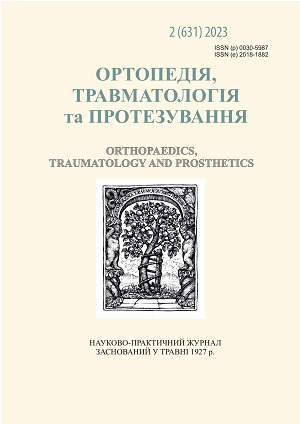ANATOMICAL AND FUNCTIONAL PREREQUISITES FOR THE DEVELOPMENT OF ENDOPROSTHESIS INSTABILITY AFTER MONOCANDYLAR KNEE ARTHROPLASTY
DOI:
https://doi.org/10.15674/0030-59872023213-18Keywords:
Еndoprosthetics, knee joint, gonarthrosis, complications, instabilityAbstract
Monocondylar knee arthroplasty allows to restore normal kinematics and function of the knee joint in the case of osteoarthritis limited to the medial or lateral part of the joint. Objective. To identify the patterns and features of secondary anatomical and functional changes in the knee joint after monocandylar arthroplasty depending on the patientʼs gender, weight, etiology of gonarthrosis, the magnitude of the primary joint deformity and bone tissue condition. Methods. The results of the examination of 71 patients (age 37–83 years, follow-up period 3–10 years) were analyzed. In 20 (28.2 %) patients, problems with the arthroplasty joint occurred. joint: increased frontal deformity angle — 8 (40 %), decreased joint mobility — 12 (60 %), pain in the implantation area — 10 (50 %). Results. Preoperative factors that may affect the outcome of monocandylar knee arthroplasty were identified. The main one is reduced bone density, especially localized osteoporosis. In the presence of osteoporotic areas in the area of arthroplasty, the risk of endoprosthesis
instability can reach 100 %. The second important factor is frontal deformities of the knee joint of more than 10°. Other factors, such as obesity, meniscal and crossed ligament injuries, fractures of the femoral and tibial condyles, also affect the development of complications, especially with a simultaneous
decrease in bone mineral density and/or significant frontal deformity of the knee joint. Conclusions. Monocondylar knee arthroplasty is a reliable, costeffective, low-traumatic method of treating gonarthrosis, but subject to clear indications for its implementation. In the long term, patients with osteoporosis, meniscal and ligamentous injuries, fractures of the condyles, and frontal deformities of more than 10° may develop signs of endoprosthesis instability.
References
- Chen, L., Liang, W., Zhang, X., & Cheng, B. (2015). Indications, outcomes, and complications of unicompartmental knee arthroplasty. Frontiers in bioscience (Landmark edition), 20(4), 689–704. https://doi.org/10.2741/4330
- Johal, S., Nakano, N., Baxter, M., Hujazi, I., Pandit, H., & Khanduja, V. (2018). Unicompartmental knee arthroplasty: the past, current controversies, and future perspectives. The journal of knee surgery, 31(10), 992–998. https://doi.org/10.1055/s-0038-1625961
- Smith, E., Lee, D., Masonis, J., & Melvin, J. S. (2020). Lateral unicompartmental knee arthroplasty. JBJS reviews, 8(3), e0044. https://doi.org/10.2106/JBJS.RVW.19.00044
- Lim, J. B. T., Pang, H. N., Tay, K. J. D., Chia, S. L., Lo, N. N., & Yeo, S. J. (2019). Clinical outcomes and patient satisfaction following revision of failed unicompartmental
- knee arthroplasty to total knee arthroplasty are as good as a primary total knee arthroplasty. The Knee, 26(4), 847–852. https://doi.org/10.1016/j.knee.2019.04.016
- Movchanyuk, V. O., Zhuk, P. M., Karpinska, O. D., Karpinsky, M.Yu., & Sukhorukov, S. I. (2022). Experimental study of bone tissue density in monocondylar knee arthroplasty according to preliminary CT data and its intraoperative determination. Trauma (Ukaine), 23(1), 12‒18. https://doi.org/10.22141/1608-1706.1.23.2022.877 (in Ukraine)
- Movchanyuk, V. O., Zhuk, P. M., Karpinska, O. D., & Karpinsky, M.Yu., Analysis of the results of monocondillary endoprosthesis in conditions of low bone density of bone tissue. Trauma (Ukaine), 23(2), 4‒16. https://doi.org/10.22141/16081706.2.23.2022.885
- Jennings, J. M., Kleeman-Forsthuber, L. T., & Bolognesi, M. P. (2019). Medial unicompartmental arthroplasty of the knee. The Journal of the American Academy of Orthopaedic Surgeons, 27(5), 166–176. https://doi.org/10.5435/JAAOS-D-17-00690
- Everitt B. S. (2006)/ The Cambridge Dictionary of Statistics. Ed. 3. The Syndicate of the Press of the University of Cambridge. England. 2006.
- Lombardi, A. V., Jr, Kolich, M. T., Berend, K. R., Morris, M. J., Crawford, D. A., & Adams, J. B. (2018). Revision of Unicompartmental Knee Arthroplasty to Total Knee Arthroplasty: Is It as Good as a Primary Result?. The Journal of arthroplasty, 33(7S), S105–S108. https://doi.org/10.1016/j.arth.2018.03.023
Downloads
How to Cite
Issue
Section
License

This work is licensed under a Creative Commons Attribution 4.0 International License.
The authors retain the right of authorship of their manuscript and pass the journal the right of the first publication of this article, which automatically become available from the date of publication under the terms of Creative Commons Attribution License, which allows others to freely distribute the published manuscript with mandatory linking to authors of the original research and the first publication of this one in this journal.
Authors have the right to enter into a separate supplemental agreement on the additional non-exclusive distribution of manuscript in the form in which it was published by the journal (i.e. to put work in electronic storage of an institution or publish as a part of the book) while maintaining the reference to the first publication of the manuscript in this journal.
The editorial policy of the journal allows authors and encourages manuscript accommodation online (i.e. in storage of an institution or on the personal websites) as before submission of the manuscript to the editorial office, and during its editorial processing because it contributes to productive scientific discussion and positively affects the efficiency and dynamics of the published manuscript citation (see The Effect of Open Access).














